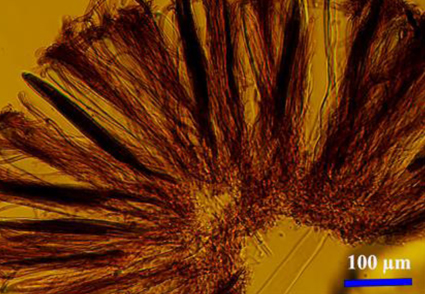Abstract
The genus Trichoglossum belongs to the family Geoglossaceae (Geoglossomycetes) and they are traditionally known as earth tongues. The genus is characterized by black or dark brown club-shaped apothecia, inoperculate asci, with prominent hymenial setae, septate paraphyses, and long septate ascospores. Currently, this genus includes more than 20 species all over the world. The present novel species (Trichoglossum benghalense) was recorded from the lower Gangetic plain of India, which indicates its cosmopolitan distribution range. A detailed morphological description supported by a DNA sequence phylogram based on Maximum likelihood (ML) and Bayesian posterior probabilities (BPP) analysis, photo-illustrations, and line drawings are provided for this interesting species. A comparison with allied accepted species is also summarized.
References
Altschul, S.F., Madden, T.L., Schaffer, A.A., Zhang, J., Zhang, Z., Miller, W. & Lipman, D.J. (1997) Gapped BLAST and PSI-BLAST: a new generation of protein database search programs. Nucleic Acids Research 25: 3389–3402. https://doi.org/10.1093/nar/25.17.3389
Arauzo, S. & Iglesias, P. (2014) La familia Geoglossaceae ss. str. en la península Ibérica y la Macaronesia. Errotari 11: 166–259.
Cash, E.K. (1958) Some new or rare Discomycetes from South America. Journal of the Washington Academy of Sciences 48 (8): 256–259.
Darriba, D., Taboada, G.L., Doallo, R. & Posada, D. (2012) jModelTest 2: more models, new heuristics and parallel computing. Nature Methods 9 (8): 772. https://doi.org/10.1038/nmeth.2109
Das, K. (2009) Mushrooms of Sikkim I: Barsey Rhododendron Sanctuary. Sikkim State Biodiversity Board, Gangtok and Botanical Survey of India, Kolkata. 1–160.
Durand, E.J. (1908) The Geoglossaceae of North America. Annales Mycologici 6: 387–477.
Durand, E.J. (1921) New or noteworthy Geoglossaceae. Mycologia 13: 184–187. https://doi.org/10.2307/3753313
Dutta, A.K., Antonín, V., Barui, R. & Acharya, K. (2018) A new species of (Marasmiaceae) from West Bengal, India. Nova Hedwigia 107 (1–2): 195–203. https://doi.org/10.1127/nova_hedwigia/2017/0464
Ekanayaka, A.H., Hyde, K.D., Jones, E.B.G., Zhao, Q., Elgorban, A.M. & Bahkali, A.H. (2017) A new species of Trichoglossum (Geoglossales, Ascomycota) from Thailand. Phytotaxa 316 (2): 161–170. https://doi.org/10.11646/phytotaxa.316.2.5
Fedosova, A.G. & Kovalenko, A.E. (2015) Studies on the geoglossoid fungi of Russia: the genus Leucoglossum. Mycolical Progress 14: 26. https://doi.org/10.1007/s11557-015-1050-2
Gardes, M. & Bruns, T.D. (1993) ITS primers with enhanced specificity for basidiomycetes application to the identification of mycorrhizae and rusts. Molecular Ecology 2: 113–118. https://doi.org/10.1111/j.1365-294X.1993.tb00005.x
Geyer, C.J. (1991) Markov chain Monte Carlo maximum likelihood. In: Keramidas, E.M. (Eds.) Computing Science and Statistics: Proceedings of the 23<sup>rd</sup> Symposium on the Interface. Fairfax Station: Interface Foundation. pp. 156–163.
Hustad, V.P. & Miller, A.N. (2015) Studies in the genus Glutinoglossum. Mycologia 107 (3): 647–657. https://doi.org/10.3852/14-328
Hustad, V.P., Miller, A.N., Dentinger, B.T.M. & Cannon, P.F. (2013) Generic circumscriptions in Geoglossomycetes. Persoonia 31: 101–111. https://doi.org/10.3767/003158513X671235
Hustad, V.P., Miller, A.N., Moingeon, J.M. & Priou, J.P. (2011) Inclusion of Nothomitra in Geoglossomycetes. Mycosphere 2: 646–654. https://doi.org/10.5943/mycosphere/2/6/5
Imai, S. (1941) Geoglossaceae Japoniae. Journal of the Faculty of Agriculture, Hokkaido Imperial University 45: 155–264.
Jaklitsch, W., Baral, H.O., Lucking, R. & Lumbsch, T.H. (2016) Syllabus of Plant Families Part1/2 Ascomycota. 13<sup>th</sup> Edition. Borntraeger Science Publishers.
Jeewon, R. & Hyde, K.D. (2016) Establishing species boundaries and new taxa among fungi: recommendations to resolve taxonomic ambiguities. Mycosphere 7: 1669–1677. https://doi.org/10.5943/mycosphere/7/11/4
Katoh, K. & Standley, D.M. (2013) MAFFT multiple sequence alignment software version 7: Improvements in performance and usability. Molecular Biology and Evolution 30: 772–780. https://doi.org/10.1093/molbev/mst010
Kornerup, A. & Wanscher, J.H. (1978) Edition. Eyre Methuen Ltd. Reprint, UK.
Ku?era, V., Lizo?, P. & Kautmanová, I. (2010) Geoglossoid fungi in Slovakia II. Trichoglossum octopartitum, a new species for the country. Czech Mycology 62 (1): 13–18.
Mains, E.B. (1940) New and unusual species of the Geoglossaceae. American Journal of Botany 27: 322–326. 591. https://doi.org/10.1002/j.1537-2197.1940.tb14689.x
Mains, E.B. (1954) North American Species of Geoglossum and Trichoglossum. Mycologia 46: 586–631. https://doi.org/10.1080/00275514.1954.12024398
Miller, M.A., Pfeiffer, W. & Schwartz, T. (2010) Creating the CIPRES Science Gateway for inference of large phylogenetic trees. In: 2010 Gateway Computing Environments Workshop (GCE). New Orleans, LA. pp. 1–8. https://doi.org/10.1109/GCE.2010.5676129
Nannfeldt, J.A. (1942) The Geoglossaceae of Sweden. (With regard also to the surrounding countries.). Arkiv for botanik 39A (4): 1– 67.
Patouillard, N. (1909) Champignons de la Nouvelle Caledonie (suite). Bulletin de la Société mycologique de France 35: 129–134.
Prabhugaonkar, A. & Pratibha, J. (2017) New record of Trichoglossum rasum from Asia. Mycosphere 8 (4): 583–591. https://doi.org/10.5943/mycosphere/8/4/7
Ronquist, F., Teslenko, M., van der Mark, P., Ayres, D.L., Darling, A., Höhna, S., Larget, B., Liu, L., Suchard, M.A. & Huelsenbeck, J.P. (2012) MrBayes 3.2: efficient Bayesian phylogenetic inference and model choice across a large model space. Systematic Biology 61 (3): 539–42. https://doi.org/10.1093/sysbio/sys029
Schoch, C.L., Wang, Z., Townsend, J.P. & Spatafora, J.W. (2009) Geoglossomycetes cl. nov., Geoglossales ord. nov., and taxa above class rank in the Ascomycota tree of life. Persoonia 22: 129–138. https://doi.org/10.3767/003158509X461486
Sinden, J.W. & Fitzpatrick, H.M. (1930) A new Trichoglossum. Mycologia 22: 55–60. https://doi.org/10.2307/3753733
Stamatakis, A. (2006) RAxML-VI-HPC: maximum likelihood-based phylogenetic analyses with thousands of taxa and mixed models. Bioinformatics 22 (21): 2688–2690. https://doi.org/10.1093/bioinformatics/btl446
Tai, F.L. (1944) Studies in the Geoglossaceae of Yunnan. Lloydia 7: 146–162.
Tamura, K., Stecher, G., Peterson, D., Filipski, A. & Kumar, S. (2013) MEGA6: molecular evolutionary genetics analysis version 6.0. Molecular Biology and Evolution 30: 2725–2729. https://doi.org/10.1093/molbev/mst197
Tennakoon, D.S., Jeewon, R., Kuo, C-H. & Hyde, K.D. (2018) Phylogenetic and morphological characterization of Byssosphaeria macarangae sp. nov., and B. taiwanense sp. nov. from Macaranga tanarius. Phytotaxa 364: 211–226. https://doi.org/10.11646/phytotaxa.364.3.1
White, T.J., Bruns, T., Lee, S. & Taylor, J.W. (1990) Amplification and direct sequencing of fungal ribosomal RNA genes for phylogenetics. In: Innis, M.A., Gelfand, D.H., Shinsky, J.J. & White, T.J. (Ed.) PCR Protocols: A Guide to Methods and Applications. Academic Press, San Diego. pp. 315–322. https://doi.org/10.1016/B978-0-12-372180-8.50042-1
Zhuang, W.Y. & Wang, Z. (1997) Some new species and new records of discomycetes in China. VII. Mycotaxon 63: 307–322.


